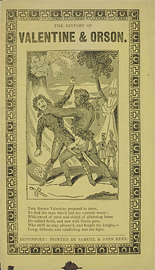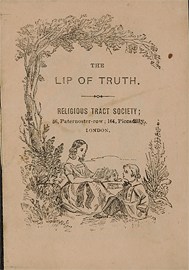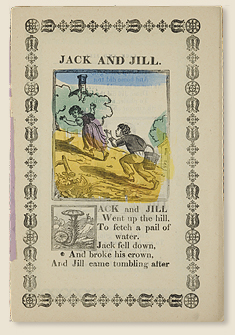Although the content of chapbook literature is far too vast to be described exhaustively here, there are several thematic trends to which chapbooks typically conform. As a general rule, chapbooks were designed to delight rather than instruct, and were "innocent of ulterior motives, didactic or otherwise" (Pedersen 105). Derived primarily from medieval romances, chapbooks featured heavily abridged and unoriginal stories that appealed to a wide cross-section of society. It is worth quoting Harry B. Weiss's list of common chapbook themes in order to give an impression of their range:
Devils, and angels, scoundrels and heroes, love and hate, murders, deathbed statements, witchcraft, riddles, tragedy, romance, song, jest, fairy tales, religion, shipwrecks, confessions, fables, hymns, speeches, executions, and all that goes to make up life, real and unreal, are reflected in the ephemeral chapbooks that once circulated so freely and are now so scarce. (Weiss 1)
 PN970 H68 S7 1825
PN970 H68 S7 1825
Weiss also offers a more detailed list of eighteen broad chapbook groupings, which is modified from Harvard's list of twenty-three subject classifications of chapbooks:
1, Religious and moral, Sunday reading, Cheap Repository Tracts; 2, Household Manuals; 3, Historical, Political, and Biographical; 4, Geographical Description and Local History; 5, Travel and Adventure; 6, Odd Characters and Strange Events; 7, Prose Fiction; 8, Legendary Romances, Fairy Stories and Folk-Tales in Prose; 9, Dramatic; 10, Metrical Tales and Other Verse; 11, Song Books; 12, Jest Books, Humorous Fiction, Riddles, etc.; 13, Humorous Metrical Tales; 14, Dream Books, Fortune Telling, and Legerdemain; 15, Demonology and Witchcraft; 16, Prophecies; 17, Crime and Criminals; 18, Miscellaneous, including Social Satire, Matrimony, Manners and Customs, Proverbs, etc. (Weiss 30)
Despite the diverse and seemingly dissonant range of chapbook themes, Susan Pedersen argues that early chapbook literature is "unified in tone" and posits that the vast majority of chapbooks are "profoundly irreverent and often amoral" (Pedersen 103). The most common chapbooks were adapted from medieval romances such as Guy of Warwick, Bevis of Southampton, The Four Sons of Aymon, and The Seven Wise Masters. Originally intended for a "literate and sophisticated medieval audience" (Neuburg [1968] 8), these and similar works were reprinted as chapbooks for humble readers in the sixteenth and seventeenth centuries.
Also influencing the production of chapbooks in England were chivalric romances from France and Germany, many of which cropped up as English chapbooks in the seventeenth and eighteenth centuries. For example, Fortunatas, which appeared in England in 1600, was first printed in Germany in 1509, and The Famous History of Valentine and Orson, which lasted for over a century as an English chapbook, was originally published in France. Despite its varied origins, what unites all chapbook literature, insists Pedersen, "is the subordination of any message or moral to the dictates of amusement" (Pedersen 105). Notable exceptions to this rule are the moral and religious tracts published by Evangelical societies, discussed below, but these did not have a serious market presence until the late eighteenth century.
 PN970 K49 V3 1840
Other popular chapbooks were the burlesques and bawdy stories featuring heroes "drawn specifically from both the urban and the rural poor" (Spufford 50). Written primarily in the sixteenth and seventeenth centuries, these stories were sceptical of authority, religious duty, hard work and other bourgeois values. They presented a world turned upside down, in which heroes from humble origins could find unaccustomed wealth, servants could marry their masters, scheming but valiant crooks emerged victorious, and the rich received their just comeuppance. The 'lottery mentality' of these books promoted the idea that one could attain wealth and stature without hard work or personal merit, and the hero typically emerged victorious by relying on such "traditional plebeian virtues as cunning and wit" (O’Malley 24). Despite being less common than the cut-down chivalric romances, these stories were often singled out by evangelical groups, such as the Religious Tract Society (RTS), and Hannah More’s Cheap Repository Tracts (CRT), who wished to condemn chapbook literature in its entirety.
PN970 K49 V3 1840
Other popular chapbooks were the burlesques and bawdy stories featuring heroes "drawn specifically from both the urban and the rural poor" (Spufford 50). Written primarily in the sixteenth and seventeenth centuries, these stories were sceptical of authority, religious duty, hard work and other bourgeois values. They presented a world turned upside down, in which heroes from humble origins could find unaccustomed wealth, servants could marry their masters, scheming but valiant crooks emerged victorious, and the rich received their just comeuppance. The 'lottery mentality' of these books promoted the idea that one could attain wealth and stature without hard work or personal merit, and the hero typically emerged victorious by relying on such "traditional plebeian virtues as cunning and wit" (O’Malley 24). Despite being less common than the cut-down chivalric romances, these stories were often singled out by evangelical groups, such as the Religious Tract Society (RTS), and Hannah More’s Cheap Repository Tracts (CRT), who wished to condemn chapbook literature in its entirety.

PN970 R9 P67 1846
Although moral and didactic chapbooks appeared in great numbers at the end of the eighteenth century, the subject matter of chapbooks changed very little between the years 1500 and 1800. With the notable exceptions of "highly abbreviated and simplified" (Feather 237) chapbook versions of Defoe and Swift, the stories were often drawn from the earliest roots of English folklore. Unlike the pamphlet, which usually circulated around some current affair and then faded away as other subjects arose, chapbooks took as their subject the immortal themes of love, lust, betrayal, death, and revenge: as Tessa Watt has observed, "[if] pamphlets were topical, chapbooks were timeless" (Watt 268). The implication is that, while the stories in chapbooks would have been familiar, they were "often without direct social relevance" (Pedersen 105). This apparent drawback was actually a desirable aesthetic, and an important factor in the continued popularity of chapbooks throughout the seventeenth and eighteenth centuries because, lacking the topicality of pamphlets, chapbooks "could be expected to sell steadily and widely over a much longer period" (Neuburg [1977] 105).

PN970 R4 L57 1870z
In the late eighteenth century, however, there was a shift as chapbooks went from being largely endogenous to the lower classes to being conceived and distributed by the middle and upper classes, or, in other words, from being produced by the lower classes to being produced for the lower classes. According to St Clair, most eighteenth-century chapbooks were "designed, manufactured, and supplied by a consortium of businessmen and portfolio investors in metropolitan London as part of a large, mature, and sophisticated sector of a centralized, cartelized, national book industry" (St Clair 81). Although many of the chapbooks produced during this period can be traced back over two hundred years to before the early-modern period, there was also an increasing trend towards moral and didactic chapbooks that had little in common with the irreverent and bawdy chapbooks of previous centuries. Although Evangelical groups, such as the CRT and the RTS, are often acknowledged as the most explicit and outspoken opponents of chapbook literature, their texts were hardly characteristic of the eighteenth century, as they only appeared in the latter half of the 1790s. Andrew O'Malley suggests that these groups are the culmination of a trend towards more respectable literature that had been progressing for most of the eighteenth century. For example, publishers such as Newbery and Marshall had been attempting to clean up the chapbook's "vulgar humor and frank references to bodily functions" as early as the 1750s and 60s (Jackson 69).
| < Prev | Next > |



